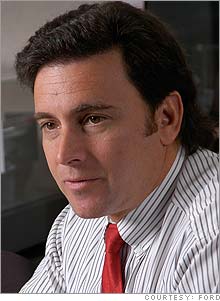Ford exec grounded from corporate jetFollowing outcry, Mark Fields, who heads Ford's money-losing North American operations, will fly commercial for weekend trips to see family in Florida.NEW YORK (CNNMoney.com) -- Mark Fields, one of the top executives at troubled automaker Ford Motor, will stop the controversial practice of using the corporate jet to make weekend trips to see his family in South Florida. Fields will instead fly on commercial flights, which will still be paid by Ford (Charts). His original arrangement to fly on corporate jets was part of his employment contract with the company, signed when he was promoted executive vice president and head of Ford's operations in the Americas. At the time he was put in charge of stemming losses at the company's struggling core automotive operations. But the recent revelation of the arrangement sparked criticism about priorities for the troubled company.
"This was Mark's decision. He doesn't want this or any other issue to distract us from the mission of the turnaround at Ford," said company spokesman Oscar Suris. "We support Mark's commitment to his family and his desire to keep us focused on this important mission." Suris would not comment on what class of commercial ticket Ford will buy for Fields. A check of Northwest Airlines' Web site shows the price of a round-trip first class seat between Detroit and Miami at $1,556, or about $90,000 for a full year. The Ford proxy statement shows that Fields' use of the corporate jet for personal travel in 2005, when he was in the job for about three months, cost the company $214,479. Multiplying those costs by four to estimate the full-year expense comes to about $900,000. Suris would not say what the cost came to in 2006, although that will be reported on the company's proxy statement some time this Spring. Fields had previously served as the head of Mazda, the Japanese automaker controlled by Ford, as well as the Premier Auto Group, its European based luxury car unit, before being named to oversee its operations here. In January of 2005 he gave a speech in which he said the automaker had to "change or die," and he unveiled a plan in January 2006 to close 14 plants by 2012. But throughout the year Ford made less progress on stemming losses than did similarly troubled competitor General Motors (Charts). But by September of that year it admitted it needed to be more aggressive with its plant-closing and cost-cut plans, saying it now saw losses continuing through 2008, and projected its U.S. market share would fall behind Toyota Motor (Charts). It offered retirement packages or buyouts to all 75,000 of its hourly workers in an effort to slash staff. More than half of those workers took the offer and agreed to leave the company. Ford also turned to an outsider, former Boeing executive Alan Mullaly, as the new CEO of the company, at that time, taking a post that had been held by Chairman Bill Ford Jr., and moving Fields one spot down on the corporate flow chart. Mulally defended the corporate flight agreement for Fields when the controversy broke, telling reporters it was worth it to the company "because you want to acquire the best talent you can around the world, and Mark is one of the very best." But he also said he would continue to evaluate the situation. |
Sponsors
|

